#sql database tutorial
Explore tagged Tumblr posts
Text

SQL Interview Questions
The following SQL interview questions and answers are designed to familiarize candidates with common interview questions.
#besttraininginstitute#traininginstitute#onlinetraining#training#online#coding#tutorial#technology#trending#design#infographics#sql#mysql#database#programming#engineering
5 notes
·
View notes
Video
youtube
How To Find My Sql Database Host Name
0 notes
Video
youtube
MS SQL Tutorial in Bengali | সহজ বাংলায় শিখুন MS SQL Server - Part-1
#youtube#MS SQL Server Tutorial Create Database MS SQL Delete Database MS SQL SQL Server Database Management SQL Server for Beginners SQL Server SSMS
0 notes
Text
SQL Reference
0 notes
Text
Efficient Data Import in SQL Server 2022: BCP vs. BULK INSERT vs. OPENROWSET
Ever found yourself swimming in an ocean of data, wondering the best way to import it into your SQL Server? You’re not alone. SQL Server 2022 comes to the rescue with a trio of tools designed to streamline this process: BCP, BULK INSERT, and OPENROWSET. Each has its unique flair for handling data, and I’m here to guide you through choosing the right tool for the job with some handy T-SQL…
View On WordPress
#BCP command examples#BULK INSERT SQL tutorial#Efficient database management SQL#OPENROWSET usage guide#SQL Server 2022 data import
0 notes
Text
learn sql server online course
elevate your skills with accredited sql server online course. gain expertise and earn a valuable certificate. start learning today!
sql database training courses ,learn sql online course ,sql server database training ,sql server complete course ,online sql training and certification ,
#sql database training courses#learn sql online course#sql server database training#sql server complete course#online sql training and certification#msbi certification#msbi training#msbi tutorial#sql server tutorial#sql server certification#power bi certification#power bi tutorial
1 note
·
View note
Text
youtube
#ntelligent Lookup#Database Views#Data Retrieval#Data Presentation#Database Optimization#Data Analysis#Database Relationships#Data Visualization#Database Tutorial#Query Optimization#Data Enhancement#Database Management#SQL Views#Data Integration#Related Tables#Youtube
0 notes
Text

Wielding Big Data Using PySpark
Introduction to PySpark
PySpark is the Python API for Apache Spark, a distributed computing framework designed to process large-scale data efficiently. It enables parallel data processing across multiple nodes, making it a powerful tool for handling massive datasets.
Why Use PySpark for Big Data?
Scalability: Works across clusters to process petabytes of data.
Speed: Uses in-memory computation to enhance performance.
Flexibility: Supports various data formats and integrates with other big data tools.
Ease of Use: Provides SQL-like querying and DataFrame operations for intuitive data handling.
Setting Up PySpark
To use PySpark, you need to install it and set up a Spark session. Once initialized, Spark allows users to read, process, and analyze large datasets.
Processing Data with PySpark
PySpark can handle different types of data sources such as CSV, JSON, Parquet, and databases. Once data is loaded, users can explore it by checking the schema, summary statistics, and unique values.
Common Data Processing Tasks
Viewing and summarizing datasets.
Handling missing values by dropping or replacing them.
Removing duplicate records.
Filtering, grouping, and sorting data for meaningful insights.
Transforming Data with PySpark
Data can be transformed using SQL-like queries or DataFrame operations. Users can:
Select specific columns for analysis.
Apply conditions to filter out unwanted records.
Group data to find patterns and trends.
Add new calculated columns based on existing data.
Optimizing Performance in PySpark
When working with big data, optimizing performance is crucial. Some strategies include:
Partitioning: Distributing data across multiple partitions for parallel processing.
Caching: Storing intermediate results in memory to speed up repeated computations.
Broadcast Joins: Optimizing joins by broadcasting smaller datasets to all nodes.
Machine Learning with PySpark
PySpark includes MLlib, a machine learning library for big data. It allows users to prepare data, apply machine learning models, and generate predictions. This is useful for tasks such as regression, classification, clustering, and recommendation systems.
Running PySpark on a Cluster
PySpark can run on a single machine or be deployed on a cluster using a distributed computing system like Hadoop YARN. This enables large-scale data processing with improved efficiency.
Conclusion
PySpark provides a powerful platform for handling big data efficiently. With its distributed computing capabilities, it allows users to clean, transform, and analyze large datasets while optimizing performance for scalability.
For Free Tutorials for Programming Languages Visit-https://www.tpointtech.com/
2 notes
·
View notes
Text
SQL GitHub Repositories
I’ve recently been looking up more SQL resources and found some repositories on GitHub that are helpful with learning SQL, so I thought I’d share some here!
Guides:
s-shemee SQL 101: A beginner’s guide to SQL database programming! It offers tutorials, exercises, and resources to help practice SQL
nightFuryman SQL in 30 Days: The fundamentals of SQL with information on how to set up a SQL database from scratch as well as basic SQL commands
Projects:
iweld SQL Dictionary Challenge: A SQL project inspired by a comment on this reddit thread https://www.reddit.com/r/SQL/comments/g4ct1l/what_are_some_good_resources_to_practice_sql/. This project consists of creating a single file with a column of randomly selected words from the dictionary. For this column, you can answer the various questions listed in the repository through SQL queries, or develop your own questions to answer as well.
DevMountain SQL 1 Afternoon: A SQL project where you practice inserting querying data using SQL. This project consists of creating various tables and querying data through this online tool created by DevMountain, found at this link https://postgres.devmountain.com/.
DevMountain SQL 2 Afternoon: The second part of DevMountain’s SQL project. This project involves intermediate queries such as “practice joins, nested queries, updating rows, group by, distinct, and foreign key”.
36 notes
·
View notes
Text
So in case you're wondering what I've been up to for the last month or so (no one is here), I've been working on this-
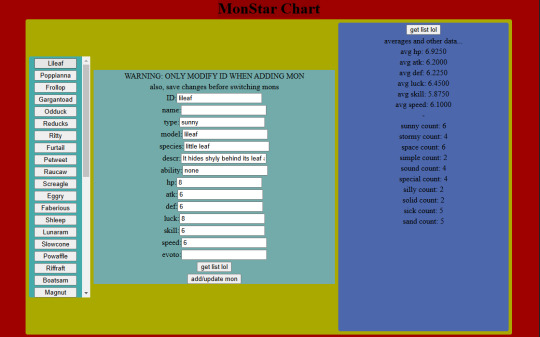
A CRUD app! Because that seems to be what everyone's making these days. It's an editor for monster data. Because, like, all the tutorials were for managing employee data and shit, but this is what data I have that needs managing. It's got a React js frontend and a javascript backend.
It basically runs off this list of data that spawns the entry rows and stuff, so I can add to it easily or reuse the base code between projects:
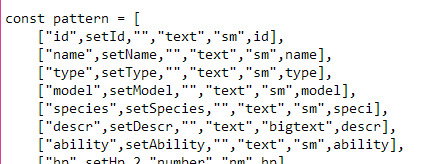
That's neat, but it was a real pain in the ass to have to start up both the client and the server whenever I wanted to use it, so I made basically the same thing but in Python with tkinter:
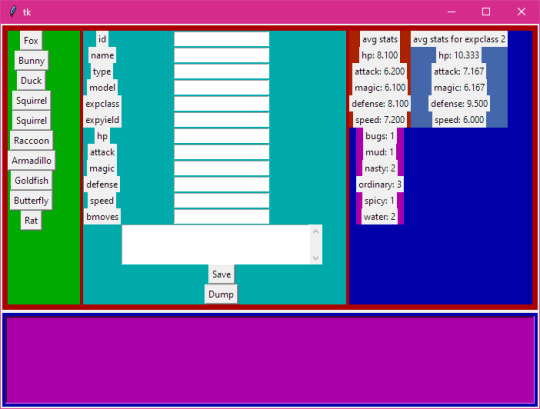
And as an example of reuse here's it being used for moves data-
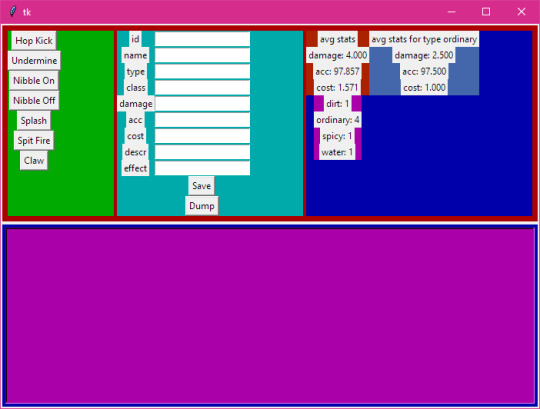
A lot of things are made easier with this. Mainly there's only one data list, whereas the CRUD app needed the state hooks declared, then the data list including the "pointers" to the state variables and setter functions, then the backend needed its own list of the names of the SQL columns.
This version has some extra features like, if you add something to the data list it'll add a column to the SQL database for you. Plus Python is similar to GDScript, so I could bundle a basic version of it with the Mondo code.
Meanwhile I've been upgrading the battle system to handle multiple mons in one battle-
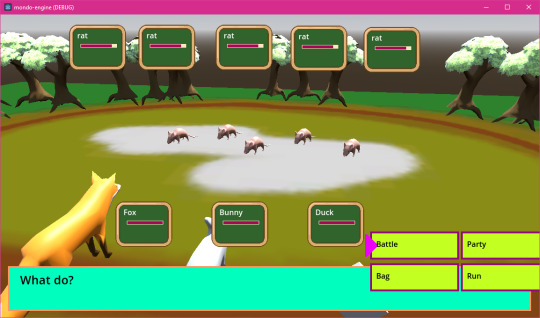
Next I'm probably going to step back a bit and document the code, because it's becoming a bit messy and I need to clean it up
5 notes
·
View notes
Text
The Complete SQL Tutorial for Beginners: Learn from the Ground Up
Start your data journey with The Complete SQL Tutorial for Beginners. Learn SQL from the ground up with easy-to-follow lessons and real-world examples!
0 notes
Text
Empowering Careers with Online Coding Courses
The Rise of Coding Education
The digital age has transformed coding into a cornerstone of opportunity, unlocking pathways to dynamic careers in technology. Across the United States, individuals from all walks of life are turning to online education to master in-demand skills. Full Stack Development Online Courses have gained immense popularity, offering comprehensive training in both front-end and back-end technologies. These programs empower aspiring developers to create fully functional web applications, making them highly valuable in today’s tech-driven job market.
The appeal of online coding education lies in its flexibility and accessibility. Whether you’re a student in Virginia, a professional seeking a career change, or a lifelong learner, these courses provide a structured yet adaptable path to proficiency. The tech industry’s rapid growth has elevated coding from a niche skill to a universal asset, enabling individuals to innovate and contribute to the digital landscape. From urban hubs to small towns, the opportunity to learn coding online is reshaping futures.
The Scope of Full Stack Development
Full stack development encompasses the art of building both the user-facing and server-side components of a website or application. Full Stack Development Online Courses teach a wide array of skills, from designing responsive interfaces with HTML, CSS, and JavaScript to managing databases and servers with tools like Node.js and SQL. This holistic approach ensures learners understand the entire development process, from crafting visually appealing front-ends to building secure, efficient back-ends.
These courses are designed for flexibility, catering to both beginners and those with some coding experience. They often include hands-on projects, such as building a portfolio website or an e-commerce platform, allowing learners to apply their skills in real-world scenarios. With interactive lessons, video tutorials, and community forums, online platforms create engaging environments that foster growth. For aspiring developers, mastering full stack development opens doors to roles like web developer, software engineer, or tech entrepreneur.
Starting with Java in Virginia
For those new to coding, starting with a foundational language like Java is a smart choice. A java course for beginners in Virginia provides an accessible entry point, teaching the basics of programming through one of the most widely used languages in the world. Java’s versatility makes it ideal for building applications, from mobile apps to enterprise systems, and its clear syntax is beginner-friendly, helping learners grasp core concepts like variables, loops, and object-oriented programming.
In Virginia, where tech hubs like Arlington and Richmond are thriving, demand for skilled programmers is on the rise. Online Java courses tailored for beginners offer Virginians the chance to learn at their own pace, with modules covering topics like data structures, algorithms, and debugging. These courses often include practical exercises, such as creating simple programs or games, to build confidence and competence. For residents seeking to enter the tech industry, a Java foundation can lead to opportunities in local startups or global corporations.
Benefits of Online Learning
Online coding courses have revolutionized education by removing barriers like location and rigid schedules. Full Stack Development Online Courses provide a comprehensive curriculum accessible from anywhere, allowing learners to study while balancing work or family commitments. Interactive platforms offer video lectures, coding challenges, and real-time feedback, ensuring an engaging learning experience. Many programs also provide certificates upon completion, enhancing resumes and signaling expertise to employers.
Similarly, a java course for beginners in Virginia leverages online tools to create a supportive learning environment. Features like live coding sessions, discussion forums, and one-on-one mentorship help demystify complex concepts. The self-paced nature of these courses allows learners to revisit lessons, ensuring they fully grasp each topic before moving forward. This flexibility is particularly valuable in Virginia, where professionals in tech-heavy regions can upskill without disrupting their busy lives.
Building a Tech Career
Learning to code is a gateway to a rewarding career, and online courses make this journey accessible to all. Full stack development equips individuals with the skills to handle diverse projects, from designing user interfaces to managing server infrastructure. This versatility makes full stack developers highly sought-after, with opportunities in industries like finance, healthcare, and e-commerce. In Virginia, where the tech sector is expanding, these skills are especially valuable, offering pathways to roles with competitive salaries.
A java course for beginners in Virginia lays the groundwork for further specialization. Java’s widespread use in enterprise applications and Android development ensures its relevance, making it a strategic starting point. Beginners who master Java can transition to advanced topics like full stack development or explore related fields like data science. With Virginia’s proximity to Washington, D.C., and its growing tech ecosystem, these skills can lead to local opportunities or remote roles with global impact.
Shaping the Future Through Code
The journey to mastering coding is both challenging and rewarding, offering a chance to create, innovate, and solve real-world problems. Full Stack Development Online Courses provide a comprehensive path to becoming a versatile developer, while a java course for beginners in Virginia offers an accessible entry into the world of programming. Together, these educational opportunities empower individuals to build skills that are both timeless and cutting-edge.
As technology continues to shape the future, coding education is a powerful tool for personal and professional growth. Whether you’re in Virginia or beyond, online courses make it possible to transform aspirations into reality, one line of code at a time. By embracing these opportunities, learners can not only launch fulfilling careers but also contribute to a world where technology drives progress and connection.
0 notes
Text
DBMS Tutorial for Beginners: Unlocking the Power of Data Management
In this "DBMS Tutorial for Beginners: Unlocking the Power of Data Management," we will explore the fundamental concepts of DBMS, its importance, and how you can get started with managing data effectively.
What is a DBMS?
A Database Management System (DBMS) is a software tool that facilitates the creation, manipulation, and administration of databases. It provides an interface for users to interact with the data stored in a database, allowing them to perform various operations such as querying, updating, and managing data. DBMS can be classified into several types, including:
Hierarchical DBMS: Organizes data in a tree-like structure, where each record has a single parent and can have multiple children.
Network DBMS: Similar to hierarchical DBMS but allows more complex relationships between records, enabling many-to-many relationships.
Relational DBMS (RDBMS): The most widely used type, which organizes data into tables (relations) that can be linked through common fields. Examples include MySQL, PostgreSQL, and Oracle.
Object-oriented DBMS: Stores data in the form of objects, similar to object-oriented programming concepts.
Why is DBMS Important?
Data Integrity: DBMS ensures the accuracy and consistency of data through constraints and validation rules. This helps maintain data integrity and prevents anomalies.
Data Security: With built-in security features, DBMS allows administrators to control access to data, ensuring that only authorized users can view or modify sensitive information.
Data Redundancy Control: DBMS minimizes data redundancy by storing data in a centralized location, reducing the chances of data duplication and inconsistency.
Efficient Data Management: DBMS provides tools for data manipulation, making it easier for users to retrieve, update, and manage data efficiently.
Backup and Recovery: Most DBMS solutions come with backup and recovery features, ensuring that data can be restored in case of loss or corruption.
Getting Started with DBMS
To begin your journey with DBMS, you’ll need to familiarize yourself with some essential concepts and tools. Here’s a step-by-step guide to help you get started:
Step 1: Understand Basic Database Concepts
Before diving into DBMS, it’s important to grasp some fundamental database concepts:
Database: A structured collection of data that is stored and accessed electronically.
Table: A collection of related data entries organized in rows and columns. Each table represents a specific entity (e.g., customers, orders).
Record: A single entry in a table, representing a specific instance of the entity.
Field: A specific attribute of a record, represented as a column in a table.
Step 2: Choose a DBMS
There are several DBMS options available, each with its own features and capabilities. For beginners, it’s advisable to start with a user-friendly relational database management system. Some popular choices include:
MySQL: An open-source RDBMS that is widely used for web applications.
PostgreSQL: A powerful open-source RDBMS known for its advanced features and compliance with SQL standards.
SQLite: A lightweight, serverless database that is easy to set up and ideal for small applications.
Step 3: Install the DBMS
Once you’ve chosen a DBMS, follow the installation instructions provided on the official website. Most DBMS solutions offer detailed documentation to guide you through the installation process.
Step 4: Create Your First Database
After installing the DBMS, you can create your first database. Here’s a simple example using MySQL:
Open the MySQL command line or a graphical interface like MySQL Workbench. Run the following command to create a new CREATE DATABASE my_first_database;
Use the database: USE my_first_database;
Step 5: Create Tables
Next, you’ll want to create tables to store your data. Here’s an example of creating a table for storing customer information:
CREATE TABLE customers ( 2 customer_id INT AUTO_INCREMENT PRIMARY KEY, 3 first_name VARCHAR(50), 4 last_name VARCHAR(50), 5 email VARCHAR(100), 6 created_at TIMESTAMP DEFAULT CURRENT_TIMESTAMP 7);
In this example, we define a table named customers with fields for customer ID, first name, last name, email, and the date the record was created.
Step 6: Insert Data
Now that you have a table, you can insert data into it. Here’s how to add a new customer:
1 INSERT INTO customers (first_name, last_name, email) 2VALUES ('John', 'Doe', '[email protected]');
Query Data
To retrieve data from your table, you can use the SELECT statement. For example, to get all customers:
1 SELECT * FROM customers;
You can also filter results using the WHERE clause:
SELECT * FROM customers WHERE last_name = 'Doe';
Step 8: Update and Delete Data
You can update existing records using the UPDATE statement:
UPDATE customers SET email = '[email protected]' WHERE customer_id = 1;
To delete a record, use the DELETE statement:
DELETE FROM customers WHERE customer_id = 1;
Conclusion
In this "DBMS Tutorial for Beginners: Unlocking the Power of Data Management," we’ve explored the essential concepts of Database Management Systems and how to get started with managing data effectively. By understanding the importance of DBMS, familiarizing yourself with basic database concepts, and learning how to create, manipulate, and query databases, you are well on your way to becoming proficient in data management.
As you continue your journey, consider exploring more advanced topics such as database normalization, indexing, and transaction management. The world of data management is vast and full of opportunities, and mastering DBMS will undoubtedly enhance your skills as a developer or data professional.
With practice and experimentation, you’ll unlock the full potential of DBMS and transform the way you work with data. Happy database management!
0 notes